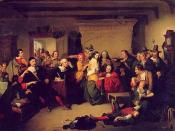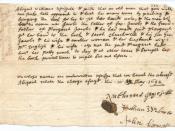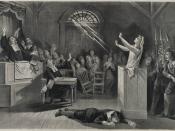In 1692, Salem, Massachusetts was a town filled with terror and suspicion. Fear of Indian attacks, oppression from England, and constant land disputes filled this New England town with hysteria. With so much hatred on the outside, how much hatred and evil was lurking amongst them in Salem, they wondered. This never-ending anxiety over what would befall them next led to the tragic blemish on American history called the Salem Witch Trials. Arthur MillerÃÂs The Crucible is a play that retells the desperate acts of the townÃÂs people in the account for religion, integrity, and hysteria. The hysteria spread like wildfire through such a small town, and with so much chaos, public order and rationality were abandoned.
Throughout this play, many displays of hysteria and loss of common sense are exemplified, the main one being the courtÃÂs unjust method of proving a man guilty. Specters, which up until the Salem Witch Trials were accounted for as weak evidence, became concrete enough to send a man to jail if he was the one who sent it into the world.
This lack of rationality lies in the fact that only the victim and the ÃÂwitchÃÂ could see it, so the general public would have to rely on the word of the victim, who could often be deceitful. Such methods were famed under the use of Abigail Williams and her fellow followers, and innocent people often paid the consequences of her actions. People, much like Abigail, took advantage of the flaws of society in order to obtain land, wealth, and fame. High government positions were now free for the taking since their previous withholders were in jail or hanged under false charges of witch craft. The state of the government during such chaos is definitely one of the major reasons of...



Good
Uses evidence from the play in an analtical controlled manner. Every point is backed up and carefully argued. A good essay
1 out of 1 people found this comment useful.